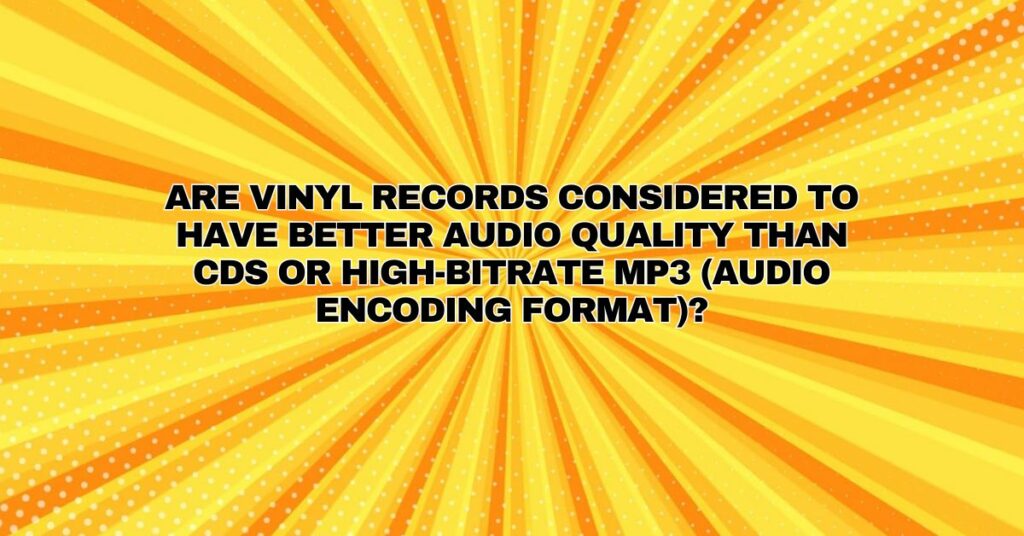The quest for audio quality has been a constant pursuit among music enthusiasts. In this article, we embark on a sonic journey to compare the audio quality of vinyl records, CDs (Compact Discs), and high-bitrate MP3s (audio encoding format). We will delve into the characteristics of each medium, their respective strengths and weaknesses, and the subjective aspects that shape the perception of audio quality. Whether you are a vinyl aficionado, a digital purist, or simply curious about the nuances of sound, this exploration will shed light on the age-old debate of analog vs. digital audio.
1. Vinyl Records: The Analog Warmth
Vinyl records are celebrated for their unique analog sound, often described as warm, organic, and immersive. Here are some key attributes of vinyl records’ audio quality:
- Analog Warmth: Vinyl records reproduce music through physical grooves, providing a rich and organic sound with harmonic distortion that many listeners find pleasing.
- Dynamic Range: Vinyl records often offer excellent dynamic range, allowing for nuances and subtleties in music to shine.
- Tactile Experience: The tactile engagement of handling vinyl and placing the needle on the record adds to the overall experience.
- Imperfections: Vinyl records may contain surface noise, clicks, and pops, which some listeners appreciate as part of the analog charm.
2. CDs: The Digital Precision
Compact Discs (CDs) ushered in the era of digital audio with their pristine sound quality. Here are some characteristics of CD audio:
- Lossless Quality: CDs offer lossless audio quality, meaning that the music is stored and played back without any compression or loss of fidelity.
- High Dynamic Range: CDs provide a wide dynamic range, preserving the subtleties and details in music.
- No Surface Noise: Unlike vinyl, CDs are free from surface noise, pops, and clicks, delivering a cleaner listening experience.
- Consistency: CDs offer consistent audio quality across plays, as they are not subject to wear and tear like vinyl records.
3. High-Bitrate MP3s: The Digital Convenience
High-bitrate MP3s represent a compromise between audio quality and file size. Here are some aspects of high-bitrate MP3 audio:
- Compression: MP3 files use compression to reduce file size while attempting to maintain acceptable audio quality.
- Portability: High-bitrate MP3s are convenient for digital music libraries and portable players, offering easy access to a vast music collection.
- Subjective Quality: The perceived audio quality of high-bitrate MP3s can vary depending on the listener’s equipment and preferences.
- Bitrate Matters: Higher bitrate MP3s (e.g., 320 kbps) generally provide better audio quality than lower bitrate versions (e.g., 128 kbps).
4. Subjective Considerations
Perceptions of audio quality are highly subjective and influenced by individual preferences, equipment, and listening environments. Some listeners prefer the warm, analog character of vinyl records, while others value the precision and convenience of digital formats like CDs and high-bitrate MP3s.
5. Conclusion
The debate over audio quality between vinyl records, CDs, and high-bitrate MP3s is nuanced and multifaceted. Each medium has its unique characteristics and appeals to different sensibilities. Vinyl records offer an analog warmth and tactile engagement, making them cherished by enthusiasts for their unique sonic signature. CDs provide pristine, lossless quality with a wide dynamic range, while high-bitrate MP3s offer convenience and portability.
Ultimately, the choice of audio medium depends on personal preferences and priorities. Some listeners prioritize audio fidelity above all else and may gravitate toward CDs. Others appreciate the nostalgic and tactile aspects of vinyl records. High-bitrate MP3s cater to the convenience-oriented digital age, where portability and accessibility are paramount.
In the end, what truly matters is the enjoyment of music, and each of these formats offers a pathway to experiencing the joy of sound in its own distinctive way. Whether you choose the analog allure of vinyl, the digital precision of CDs, or the portability of MP3s, the pursuit of audio quality is a journey that continues to evolve with technology and personal taste.


